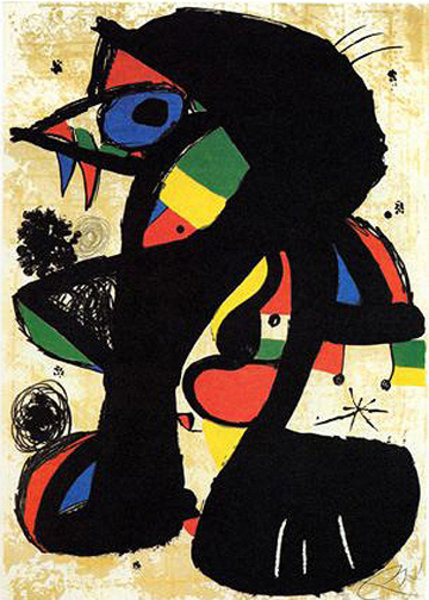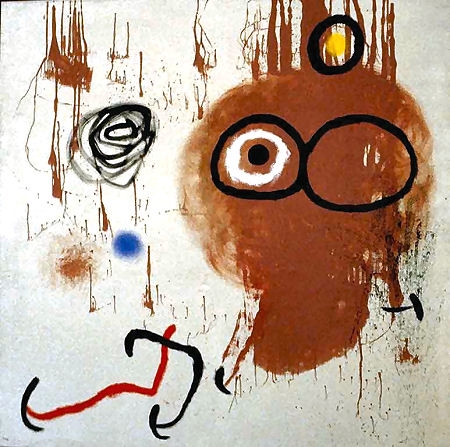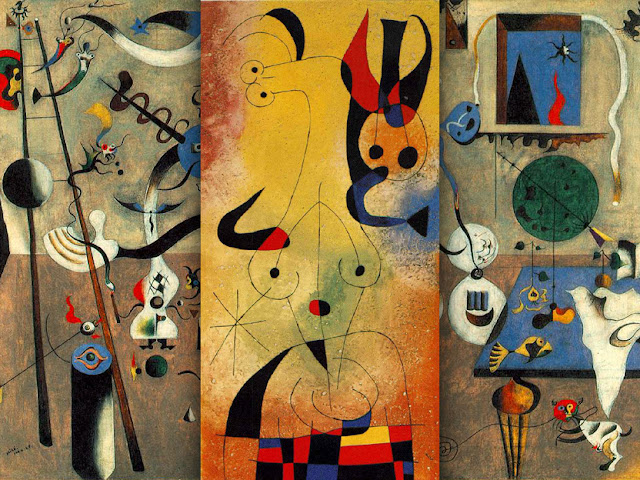joan miró art
Joan Miró
Joan Miró (1893-1983)
A Spanish artist and sculptor, Miró participated in the Surrealist Movement during the 1920s. His early paintings, including Vegetable Garden With Donkey (1918) and The Farm (1921-22), are earthy depictions of the Catalan landscape, demonstrating a sensitivity toward nature. By 1923, the artist's imagery had moved away from observed reality and toward a child-like symbolism. Among his seminal works from this period are The Tilled Field (1923-24), The Hunter (1923-24) and The Harlequin's Carnival (1924-25). With The Birth of the World (1925), Miró created a wash of dark colors upon his canvas, out of which emerged forms and lines, suggesting the origins of both human thought and the universe. The presence of amorphous shapes, floating in an undefined space, characterize much of his subsequent work. Examples are Personages and Mountains (1936), The Song of the Nightingale and the Morning Rain(1940), Ciphers and Constellations in Love with a Woman (1941) andThe Red Disk (1960).
In addition to his paintings, Miró created sculptures, Surrealist objects, ceramics, murals and set designs for Russian dance impresario Sergei Diaghilev. His unique, internal perspective, brimming with humor and innocence, left a lasting impression on Surrealist art.
| He soon became known in the community as a Surrealist because of his love for automatism and the use of sexual symbols in much of his work. Joan Miro was very much against the established painting methods of the time, and is often credited with being the founder of automatic drawing. Automatic drawing is the process of allowing the hand to move randomly on the canvas, leaving the artwork to chance. Many Surrealists believed that this form of drawing would reveal something about the subconscious human mind. For Joan Miro, automatic drawing was also a way to breaking free from conventional form. Miro was very much against bourgeois art, claiming that it was used for propaganda and the promotion of a wealthy culture. Miro referred to his work as the assassination of painting. |
During the height of his career, Joan Miro experimented with many different types of art form, refusing to commit to one artistic movement. Later in his career he began experimenting with tapestry. In 1974 he created World Trade Center Tapestry for the newly constructed Twin Towers. This work would later become the most expensive piece of art lost in the World Trade Center attacks of September 11th.
| Joan Miro also began to delve into other aspects of media, including ceramics and window paintings. Some of his more radical ideas included four-dimensional art, and gas sculptures, though he was never able to put these ideas into practice.
Perhaps his most important work of art in the United States is a glass mural titled Personnage Oiseaux, which was made for the Edwin A. Ulrich Museum of Art at Wichita State University in Kansas. Joan Miro began this large two-dimensional project at the age of 79, and it was not completely until he was 85 years old. The mural is made up of one million pieces of marble and Venetian glass, mounted on a special type of wood, and was attatched to the concrete wall of the museum. It was the first glass mosaic ever attempted by Miro, and though he wanted to make more, his deteriorating health prevented any future attempts of another project.
At the time of his death, Joan Miro was bedridden from heart disease and respiratory complications. He died at his home in Palma, Mallorca on December 25th, 1983. He is buried in his home town of Barcelona, near a museum that is dedicated entirely to his work. Today, his works are displayed in museums and galleries all over the world, and sell for anywhere between $250,000 and $17 million. |
















.jpg)

















.jpg)



.jpg)






The very first picture of "Miro's cat..." is not a Miro painting but a dedication to Miro by Eve Riser Robert. You can even see it is signed by her.
ReplyDeleteIf you go to her webpage you can read about
Miro’s Cat
Copyright Eve Riser-Roberts 2000
All Rights Reserved
So please don’t snag my baby